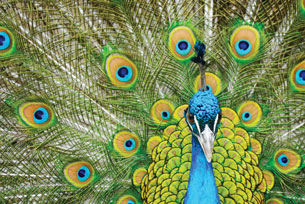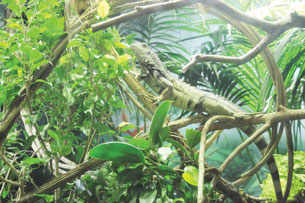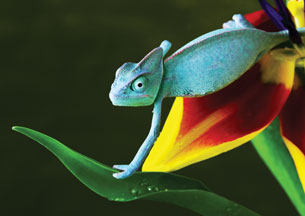Module 4 Intro
1. Module 4 Intro
1.6. Page 4
Module 4—Mechanisms of Population Change
 Read
Read

© Scott A. Maxwell / LuMaxArt/shutterstock
Natural selection determines what variations will survive and what variations will die out. Only those organisms best adapted to the environment will survive and pass on their genetic characteristics to the next generation. Those organisms less adapted will not survive, and their traits will not be passed on. For example, the fast and fit figurines in the illustration to the left will survive the stomping attack of the giant stick man. They will be able to reproduce and pass on to their offspring the characteristics that helped them survive. In time, the characteristics of the population change due to the surviving traits. Charles Darwin developed his theory
natural selection: the process that results when the characteristics of a population of organisms change because individuals with certain inherited traits survive specific local environmental conditions and, through reproduction, pass on their traits to their offspring
sexual selection: a type of natural selection where characteristics are selected based on mate preferences
of natural selection to explain how populations change or evolve over time. The development and evidence supporting this theory will be discussed in more detail in Lesson 2.
Read page 118 of the textbook, starting at “Natural Selection.” Continue reading up to “Section 4.1 Summary” on page 121. You may skim over the Thought Labs.
The desire to mate is strong in all organisms, and it creates a strong selection pressure. In some cases, the mates’ selective pressure is oblivious to other environmental selection pressures. Selecting characteristics based on attracting a mate is called sexual selection.
 Watch and Listen
Watch and Listen
The Peacock and Natural Selection

© Eric Gevaert/shutterstock
Have you ever wondered why the peacock has evolved a beautiful, long tail? The theory of sexual selection in peacocks is explored in a video found on the PBS website. To find this video, type in the keywords “pbs evolution library peacock tale.” If this video is unavailable to you, continue searching the Internet for answers to the following question:
- Why do male peacocks have long, beautiful tails that make it more difficult to escape from predators?
Explain your answer using images, text, or a combination of both. Your explanation could be in the form of a comic, a story, or a summary. Place this explanation in your course folder and in the Lesson 1 Assignment.
Click to view the marking rubric for this activity.
| 4 | 3 | 2 | 1 | |
|---|---|---|---|---|
| Accuracy of Explanation | The explanation is very accurate and detailed. | The explanation is accurate and detailed. | The explanation is accurate. | The explanation is inaccurate. |
| Clarity of Explanation | The explanation is very easy to interpret and understand. | The explanation is easy to interpret and understand. | The explanation is somewhat difficult to understand. | The explanation is difficult to understand. |
 Read
Read

© Natallia Rasadka /shutterstock

© Sebastian Duda/shutterstock
Abiotic and biotic environmental conditions can exert selective pressure on a population by selecting for certain characteristics. These selected characteristics allow the individual to survive. In the photos above, which of the two lizards is more likely to be preyed upon?
Actually, both the iguana and the chameleon are adapted to blend into or mimic their environment. If the environment of each lizard were to change drastically, and they were no longer camouflaged, the lizards could be in greater danger than those that blend in better.
In the peppered moth activity, the soot darkening the forest is an example of an abiotic environmental condition exerting a selective pressure on the population of peppered moths. The agent of this selection—the blue jay—is biotic. The soot-darkened forest selected for the dark-coloured moths and against the light-coloured moths. Therefore, the dark-coloured moth population increased and the light-coloured moth population decreased.
Selective pressure can also be exerted by a biotic component in the environment, as was observed with sexual selection. Predators are another example of a biotic component in the environment exerting a selection pressure.
 Try This
Try This
TR 2. Selective Pressures
Answer the TR 2. Selective Pressures questions in the Lesson 1 Assignment.